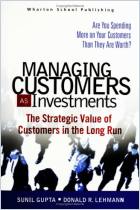Melden Sie sich bei getAbstract an, um die Zusammenfassung zu erhalten.

Melden Sie sich bei getAbstract an, um die Zusammenfassung zu erhalten.
Peter Fader and Sarah Toms
The Customer Playbook
Talks at Google, 2019
Was ist drin?
When you’re only looking at revenue, you’re missing most of the picture.
Recommendation
When Peter Fader and Sarah Toms wrote a book called The Customer Centricity Playbook, people tended to read the title and assume that it was about putting customers at the center of business decisions, along with some iteration of “the customer is always right.” That is not what the book is about. In this Talk at Google, Fader and Toms explore the concept of the “good customer,” customer heterogeneity, and customer lifetime value, while also explaining four principles of customer centricity and a call for a radical change in metrics for corporate valuation.
Summary
About the Speakers
Peter Fader is a professor of marketing at the Wharton School of the University of Pennsylvania, and Sarah E. Toms is the executive director and co-founder of Wharton Interactive. Together, Fader and Toms co-authored The Customer Centricity Playbook.






















Comment on this summary